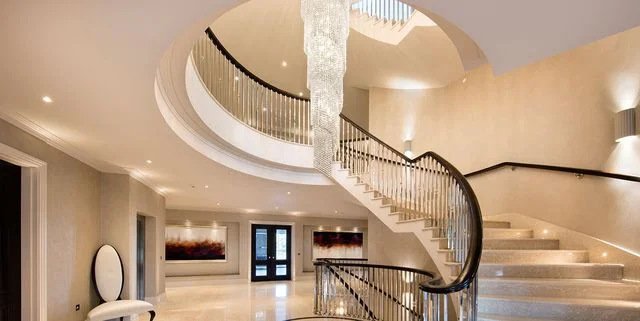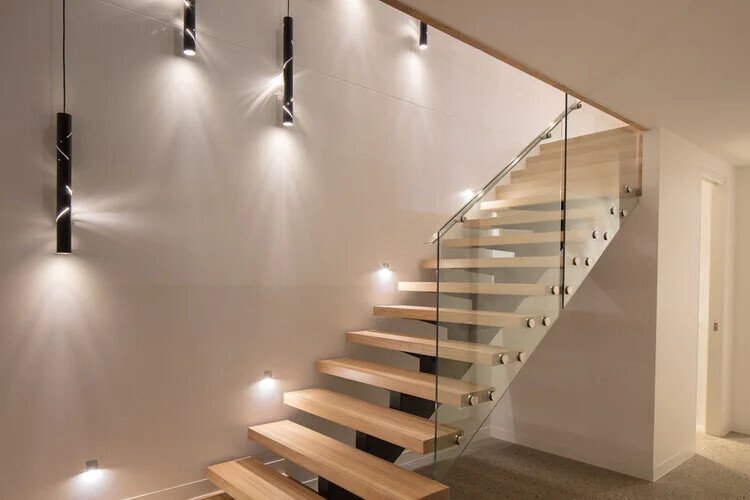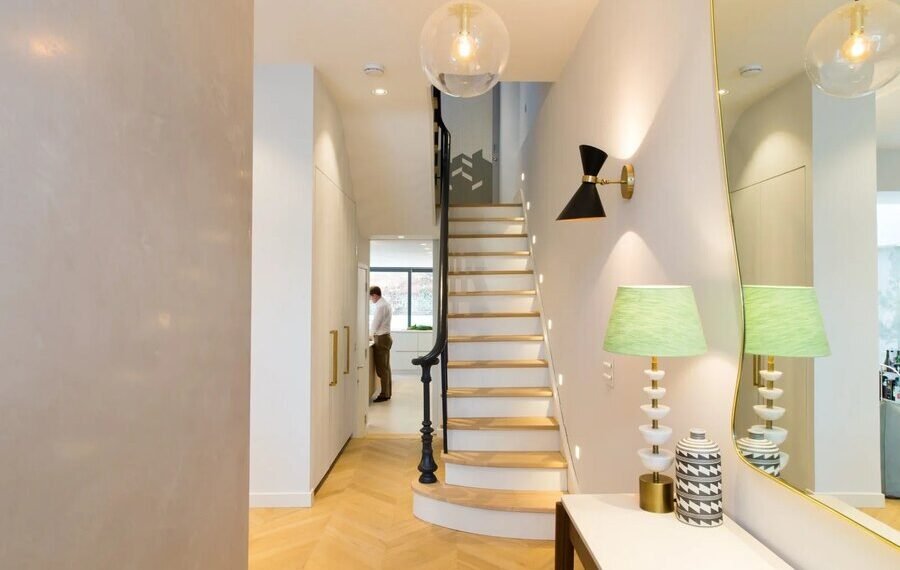Lighting serves as the silent orchestrator of ambiance within any space, wielding the power to transform a dull room into an inviting sanctuary. Beyond mere illumination, it shapes the mood, highlights architectural features, and enhances the overall aesthetic appeal of a room.
From natural sunlight streaming through windows to strategically placed fixtures, lighting, including the elegant and stunning seus lighting staircase chandelier, plays a pivotal role in creating atmosphere, functionality, and visual interest within interiors.
Introduction To The Topic Of Enhancing Staircases With Designer Chandeliers
Among the myriad ways to elevate interior spaces, the staircase stands as a focal point, commanding attention as a transitional element that connects different levels of a home or establishment. Often overlooked, staircases present a unique opportunity for creative expression in interior design.
Introducing designer chandeliers to adorn staircases not only serves a practical purpose by illuminating the path but also adds an element of luxury, sophistication, and visual intrigue to an otherwise utilitarian structure.
Introduction To Designer Chandeliers
Definition And Characteristics
Designer chandeliers stand as epitomes of elegance and sophistication in the realm of interior design. These exquisite fixtures, typically suspended from ceilings, feature multiple arms or branches adorned with lights, crystals, or other decorative elements. What distinguishes designer chandeliers from their conventional counterparts is their meticulous craftsmanship, unique designs, and premium materials, which elevate them to coveted pieces of functional art within interior spaces.
Crafted with attention to detail and an emphasis on aesthetics, designer chandeliers are characterized by their exquisite beauty, intricate ornamentation, and superior quality. They serve not only as sources of illumination but also as statement pieces that command attention and imbue spaces with a sense of grandeur and luxury.
Evolution Of Chandelier Design
The history of chandeliers traces back centuries, evolving from humble candle-holders to elaborate masterpieces that adorned the palaces of royalty and the salons of the elite. Initially crafted from wood, metal, or wrought iron, chandeliers underwent a transformation during the Renaissance period, with the introduction of ornate designs embellished with crystals, glass, and precious metals.
Over time, advancements in technology and design innovation revolutionized chandelier production, leading to the creation of more intricate and elaborate forms. The Victorian era saw the proliferation of crystal chandeliers, characterized by their shimmering facets and opulent aesthetics, while the Art Deco movement embraced geometric shapes, sleek lines, and innovative materials to create chandeliers that epitomized modern elegance.
Designer chandeliers continue to evolve, incorporating cutting-edge technology, sustainable materials, and avant-garde designs to push the boundaries of creativity and redefine traditional notions of lighting fixtures. From minimalist masterpieces that exude understated sophistication to avant-garde creations that challenge conventional design norms, today’s designer chandeliers offer a diverse array of styles, shapes, and materials to suit every taste and preference.
Versatility In Interior Spaces
One of the most remarkable aspects of designer chandeliers is their versatility, transcending traditional boundaries to grace a wide range of interior spaces with their luminous presence. No longer confined to ballrooms and grandiose halls, designer chandeliers have found their way into modern homes, boutique hotels, upscale restaurants, and commercial establishments, where they serve as focal points that elevate the overall ambiance and aesthetic appeal of the space.
From intimate dining rooms and cozy living areas to expansive foyers and majestic staircases, designer chandeliers can be tailored to suit any environment, adding a touch of glamour, drama, or whimsy as desired. Their ability to capture and refract light creates a captivating interplay of shadows and reflections, casting a spellbinding aura that transforms ordinary spaces into extraordinary sanctuaries.
Moreover, designer chandeliers offer endless opportunities for customization, allowing homeowners and designers to collaborate with artisans and craftsmen to create bespoke pieces that perfectly complement the architectural style and interior decor of the space. Whether seeking a timeless classic or a contemporary showstopper, the versatility of designer chandeliers ensures that there exists a perfect match for every setting and design aesthetic.
Understanding The Role Of Lighting In Interior Design
The Importance of Lighting in Creating Ambience and Functionality
Lighting is akin to the conductor of a symphony, setting the tone and rhythm of a space. Beyond its functional aspect of providing visibility, it plays a pivotal role in crafting ambiance and mood. Whether aiming for a cozy, intimate setting or a bright, energetic atmosphere, the strategic manipulation of light can evoke desired emotions and enhance the overall experience within a room. In the context of staircases, lighting serves dual purposes: it ensures safe passage while also accentuating the architectural beauty of the stairs themselves.
Different Types Of Lighting Fixtures Used In Interior Design
In the toolbox of interior designers, an array of lighting fixtures awaits, each serving a specific purpose and contributing to the overall design scheme. From the soft glow of recessed lighting to the dramatic flair of pendant lights, the options are limitless. Among these, chandeliers emerge as timeless statement pieces that exude opulence and grandeur. Traditionally associated with formal dining rooms and grand foyers, chandeliers have transcended their conventional roles to become versatile accents suitable for various spaces, including staircases.

The realm of staircase illumination, it becomes evident that designer chandeliers offer a harmonious fusion of form and function. Beyond their primary task of illuminating the path, they serve as works of art suspended in space, captivating the gaze and adding a touch of glamor to the vertical ascent. From sleek, contemporary designs to ornate, vintage-inspired pieces, the diversity of chandelier styles ensures compatibility with a range of interior aesthetics, allowing homeowners and designers to unleash their creativity and elevate staircases from mere passageways to captivating focal points.
Factors To Consider When Choosing Designer Chandeliers For Staircases
Size And Scale Considerations For Chandeliers In Relation To Staircase Dimensions
When selecting a designer seus lighting staircase chandelier to grace your staircase, one of the foremost considerations is ensuring the fixture harmonizes with the scale and proportions of the space. Staircases come in an array of sizes and configurations, from grand, sweeping designs to compact, spiral variants. Thus, it is imperative to choose a chandelier that complements rather than overwhelms or underwhelms the staircase.
Begin by assessing the vertical clearance available above the staircase. Ideally, the chandelier should hang at a height that allows for safe passage without obstructing the view or posing a hazard. For standard ceiling heights, a chandelier that hangs approximately 7 to 9 feet above the lowest point of the staircase provides an optimal balance between visual impact and practicality.
Moreover, consider the width of the staircase and the space available for the chandelier to spread its luminous embrace. A chandelier that is too narrow may appear diminutive and lost within the expanse of the staircase, while one that is too wide risks overwhelming the space and impeding movement along the stairs. As a general rule, the diameter of the chandelier should be proportional to the width of the staircase, with larger staircases accommodating more substantial fixtures for a commanding presence.

Conclusion
Designer chandeliers to staircases offer a multitude of benefits that extend beyond mere illumination. These exquisite fixtures serve as focal points, infusing staircases with a sense of luxury, style, and sophistication. By carefully selecting seus lighting staircase chandelier that complement the scale and style of the staircase, homeowners and designers can create visually stunning compositions that elevate the entire space. Moreover, the strategic placement of chandeliers enhances safety and functionality while accentuating the architectural beauty of the stairs themselve.
















